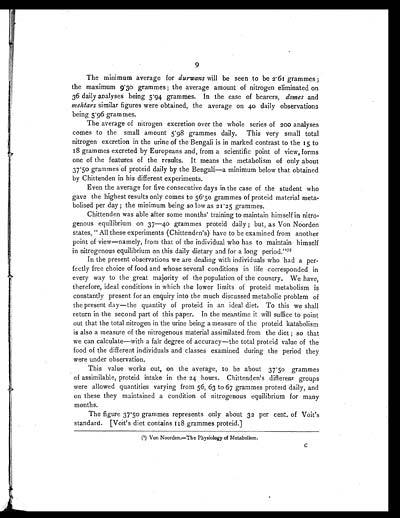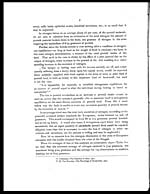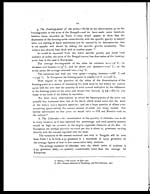Medicine - Institutions > Army health reports and medical documents > Scientific memoirs by officers of the Medical and Sanitary Departments of the Government of India > Number 34 - Standards of the constituents of the urine and blood and the bearing of the metabolism of Bengalis on the problems of nutrition > Standards of the constituents of the urine and blood and the bearing of the metabolism of Bengalis on the problems of nutrition
(17) Page 9
Download files
Individual page:
Thumbnail gallery: Grid view | List view

9
The minimum average for durwans will be seen to be 2.61 grammes ;
the maximum 9.30 grammes; the average amount of nitrogen eliminated on
36 daily analyses being 5.94 grammes. In the case of bearers, domes and
mehtars similar figures were obtained, the average on 40 daily observations
being 5.96 grammes.
The average of nitrogen excretion over the whole series of 200 analyses
comes to the small amount 5.98 grammes daily. This very small total
nitrogen excretion in the urine of the Bengali is in marked contrast to the 15 to
18 grammes excreted by Europeans and, from a scientific point of view, forms
one of the features of the results. It means the metabolism of only about
37.50 grammes of proteid daily by the Bengali—a minimum below that obtained
by Chittenden in his different experiments.
Even the average for five consecutive days in the case of the student who
gave the highest results only comes to 56.50 grammes of proteid material meta-
bolised per day; the minimum being so low as 21.25 grammes.
Chittenden was able after some months' training to maintain himself in nitro-
genous equilibrium on 37—40 grammes proteid daily; but, as Von Noorden
states, "All these experiments (Chittenden's) have to be examined from another
point of view—namely, from that of the individual who has to maintain himself
in nitrogenous equilibrium on this daily dietary and for a long period."(1)
In the present observations we are dealing with individuals who had a per-
fectly free choice of food and whose several conditions in life corresponded in
every way to the great majority of the population of the country. We have,
therefore, ideal conditions in which the lower limits of proteid metabolism is
constantly present for an enquiry into the much discussed metabolic problem of
the present day—the quantity of proteid in an ideal diet. To this we shall
return in the second part of this paper. In the meantime it will suffice to point
out that the total nitrogen in the urine being a measure of the proteid katabolism
is also a measure of the nitrogenous material assimilated from the diet; so that
we can calculate—with a fair degree of accuracy—the total proteid value of the
food of the different individuals and classes examined during the period they
were under observation.
This value works out, on the average, to be about 37.50 grammes
of assimilable, proteid intake in the 24 hours. Chittenden's different groups
were allowed quantities varying from 56, 63 to 67 grammes proteid daily, and
on these they maintained a condition of nitrogenous equilibrium for many
months.
The figure 37.50 grammes represents only about 32 per cent. of Voit's
standard. [Voit's diet contains 118 grammes proteid.]
(1) Von Noorden.—The Physiology of Metabolism.
c
Set display mode to: Large image | Zoom image | Transcription
Images and transcriptions on this page, including medium image downloads, may be used under the Creative Commons Attribution 4.0 International Licence unless otherwise stated. ![]()
| Permanent URL | https://digital.nls.uk/75032285 |
|---|




